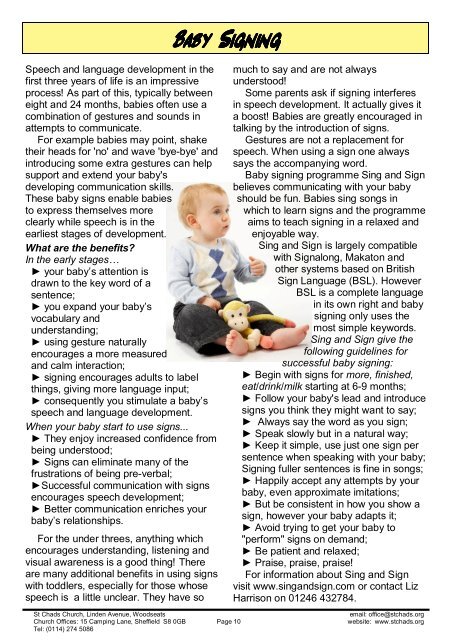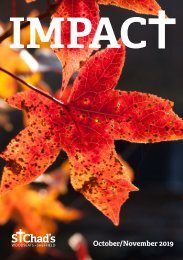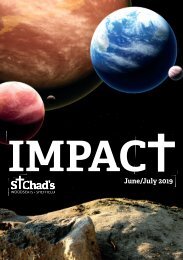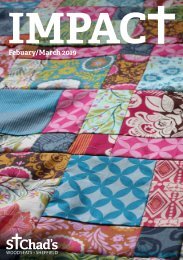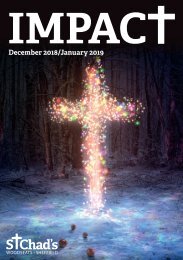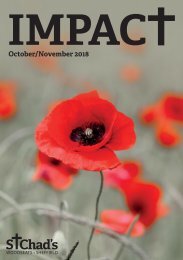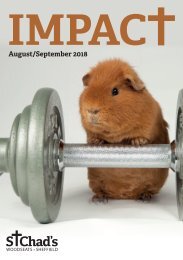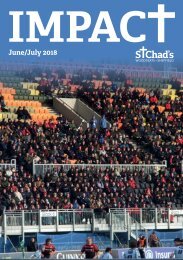2009-06
2009-06
2009-06
You also want an ePaper? Increase the reach of your titles
YUMPU automatically turns print PDFs into web optimized ePapers that Google loves.
Speech and language development in the<br />
first three years of life is an impressive<br />
process! As part of this, typically between<br />
eight and 24 months, babies often use a<br />
combination of gestures and sounds in<br />
attempts to communicate.<br />
For example babies may point, shake<br />
their heads for 'no' and wave 'bye-bye' and<br />
introducing some extra gestures can help<br />
support and extend your baby's<br />
developing communication skills.<br />
These baby signs enable babies<br />
to express themselves more<br />
clearly while speech is in the<br />
earliest stages of development.<br />
What are the benefits?<br />
In the early stages…<br />
► your baby’s attention is<br />
drawn to the key word of a<br />
sentence;<br />
► you expand your baby’s<br />
vocabulary and<br />
understanding;<br />
► using gesture naturally<br />
encourages a more measured<br />
and calm interaction;<br />
► signing encourages adults to label<br />
things, giving more language input;<br />
► consequently you stimulate a baby’s<br />
speech and language development.<br />
When your baby start to use signs...<br />
► They enjoy increased confidence from<br />
being understood;<br />
► Signs can eliminate many of the<br />
frustrations of being pre-verbal;<br />
►Successful communication with signs<br />
encourages speech development;<br />
► Better communication enriches your<br />
baby’s relationships.<br />
For the under threes, anything which<br />
encourages understanding, listening and<br />
visual awareness is a good thing! There<br />
are many additional benefits in using signs<br />
with toddlers, especially for those whose<br />
speech is a little unclear. They have so<br />
B S<br />
much to say and are not always<br />
understood!<br />
Some parents ask if signing interferes<br />
in speech development. It actually gives it<br />
a boost! Babies are greatly encouraged in<br />
talking by the introduction of signs.<br />
Gestures are not a replacement for<br />
speech. When using a sign one always<br />
says the accompanying word.<br />
Baby signing programme Sing and Sign<br />
believes communicating with your baby<br />
should be fun. Babies sing songs in<br />
which to learn signs and the programme<br />
aims to teach signing in a relaxed and<br />
enjoyable way.<br />
Sing and Sign is largely compatible<br />
with Signalong, Makaton and<br />
other systems based on British<br />
Sign Language (BSL). However<br />
BSL is a complete language<br />
in its own right and baby<br />
signing only uses the<br />
most simple keywords.<br />
Sing and Sign give the<br />
following guidelines for<br />
successful baby signing:<br />
► Begin with signs for more, finished,<br />
eat/drink/milk starting at 6-9 months;<br />
► Follow your baby's lead and introduce<br />
signs you think they might want to say;<br />
► Always say the word as you sign;<br />
► Speak slowly but in a natural way;<br />
► Keep it simple, use just one sign per<br />
sentence when speaking with your baby;<br />
Signing fuller sentences is fine in songs;<br />
► Happily accept any attempts by your<br />
baby, even approximate imitations;<br />
► But be consistent in how you show a<br />
sign, however your baby adapts it;<br />
► Avoid trying to get your baby to<br />
"perform" signs on demand;<br />
► Be patient and relaxed;<br />
► Praise, praise, praise!<br />
For information about Sing and Sign<br />
visit www.singandsign.com or contact Liz<br />
Harrison on 01246 432784.<br />
St Chads Church, Linden Avenue, Woodseats<br />
email: office@stchads.org<br />
Church Offices: 15 Camping Lane, Sheffield S8 0GB Page 10 website: www.stchads.org<br />
Tel: (0114) 274 5086


